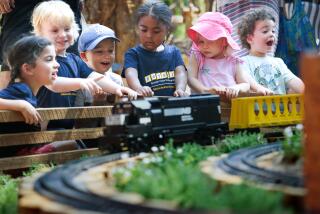AROUND HOME : Notes on Model Trains : PASTIMES : All Aboard
- Share via
AMTRAK MAY BE struggling to avoid derailment in the late 20th Century, but one form of railroading never seems to stop chugging along: model trains.
At first there were toy trains, which appeared in England in the mid-1860s; scale-model railroads, complete to the last detail and run by electricity, were not available in this country until the 1920s, when only little princes and their kingpin fathers could afford them. That has changed; five years ago (the most recent report) model railroading brought in about $130 million in retail sales; about 250 million people, most of them adults, had model railroads.
The beginning model railroader, no matter what age, faces a bewildering array of expensive imports, gauges, scales, accessories and thousands of pieces of fully painted rolling stock. There are also kits: sets or individual cars and engines, unassembled, unpainted. Most model-train stores will put a starter set together, which is generally preferable to the more cheaply made prepackaged kits.
Farther along the upscale, water tanks, houses, saloons and other buildings are available in kit form (and finished), most in plastic, some in wood, with a significant price range within each material (kits are not always cheaper than ready-mades). An unassembled, unpainted balsa-wood caboose costs about $24; a black plastic chemical tank kit in HO gauge costs $6 or so.
If assembling and painting plastic or wooden cars and cabooses is not challenging enough, there is the Aster live steam locomotive imported from England. Sized to fit G-gauge track, the Aster is powered by alcohol, with 250 pieces that need to be assembled. Cost: a mere $495.
There are several gauges available, from the smallest, Z, through N (which stands for 9 millimeters, the width of the track), to the largest, G (for giant), including O (the Lionel trains) and HO (for half O), the most popular. The bigger the system, obviously, the more room it needs for track. For those who think huge, consider the model-train layout at the Los Angeles County Fairgrounds in Pomona, a venerable system that was first moved outdoors in 1935; it has an old gauge--2 1/2 inches between rails--and occupies just a bit less than three-quarters of an acre with four main lines. Also, the San Diego Model Railroad Museum in Balboa Park has four scale-model layouts in three gauges.
Model trains, kits, books, magazines, paints and accessories are sold at Allied Model Trains, West Los Angeles ; the Whistle Stop, Pasadena; the Little Depot, Anaheim; South Bay Model Railroad Supply Co., Redondo Beach, and other hobby stores throughout Southern California.
The magazine Model Railroader was started in 1934 and still serves scale-model aficionados . A subscription costs $25 for 12 issues; the address is 1027 N. 7th St., Milwaukee, Wis. 53233. DR, Ayse Ulay
More to Read
Sign up for The Wild
We’ll help you find the best places to hike, bike and run, as well as the perfect silent spots for meditation and yoga.
You may occasionally receive promotional content from the Los Angeles Times.






